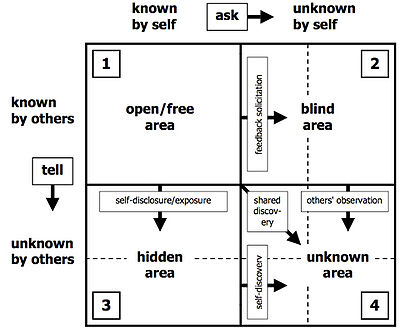Managing Group Development using the Johari Window
(→History) |
(→History) |
||
| Line 9: | Line 9: | ||
The Johari Window was developed in 1955 by American psychologists Joseph Luft (1916-2014) and Harrington Ingham (1916-1995) <ref name="Wikipedia">Wikipedia. [https://en.wikipedia.org/wiki/Johari_window Johari Window]. Retrieved 10 September 2016.</ref> from whom the name Johari was derived combining both of the psychologists names. It was initially a psychological tool to enhance self-awareness but continued to expand towards being a communication tool, inter-group development- and intra-group development tool, with the common purpose to enhance self-awareness, increase effective group development and demolish communication barriers. (....) | The Johari Window was developed in 1955 by American psychologists Joseph Luft (1916-2014) and Harrington Ingham (1916-1995) <ref name="Wikipedia">Wikipedia. [https://en.wikipedia.org/wiki/Johari_window Johari Window]. Retrieved 10 September 2016.</ref> from whom the name Johari was derived combining both of the psychologists names. It was initially a psychological tool to enhance self-awareness but continued to expand towards being a communication tool, inter-group development- and intra-group development tool, with the common purpose to enhance self-awareness, increase effective group development and demolish communication barriers. (....) | ||
| − | [[File: | + | [[File:Johari Window.jpg|400px|thumb|right|Figure 1. – Johari Window <ref name="Johari Window"/>]] |
== The Johari Window and its purpose == | == The Johari Window and its purpose == | ||
Revision as of 14:58, 11 September 2016
The Johari Window is a psychological model for effective group development and self-awareness and plants its roots in the human behavioral phenomenon. Failing to manage group development can result in ineffective group communication, and hence be the source of various downfalls of project execution, streaming from prevention of information sharing to decreased performance and unproductiveness. In order to prevent these circumstances, it is important for each project member to embrace self-awareness, enable dynamics and create effective group development.
In this article the Johari Window will be discussed as a means to prevent ineffective group development and increase effective group communication. A valuable insight into the framework and purpose of the Johari Window will be given in which the four quadrants will be described thoroughly. Additionally, the Shannon-Weaver model of communication and Tuckman's stages of group development will briefly be touched upon along with the importance of feedback, to stress the necessity of managing group development, and simultaneously create a link between the models. This article draws upon psychological and managerial theories to enrich the findings, and will end with a critical view point of the Johari Window in which the limitations will be discussed.
Contents |
History
The Johari Window was developed in 1955 by American psychologists Joseph Luft (1916-2014) and Harrington Ingham (1916-1995) [1] from whom the name Johari was derived combining both of the psychologists names. It was initially a psychological tool to enhance self-awareness but continued to expand towards being a communication tool, inter-group development- and intra-group development tool, with the common purpose to enhance self-awareness, increase effective group development and demolish communication barriers. (....)

The Johari Window and its purpose
(.....)
The 4 Quadrants
Group Development
Communication channels and the Johari Window
Application
(.....)
Limitations
(.....)
Annotated Bibliography
References
- ↑ Wikipedia. Johari Window. Retrieved 10 September 2016.
- ↑ Cite error: Invalid
<ref>tag; no text was provided for refs namedJohari_Window